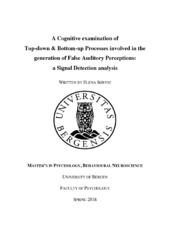| dc.contributor.author | Sørvig, Elena | |
| dc.date.accessioned | 2018-10-31T17:46:46Z | |
| dc.date.issued | 2018-06-20 | |
| dc.date.submitted | 2018-06-19T22:00:05Z | |
| dc.identifier.uri | https://hdl.handle.net/1956/18688 | |
| dc.description.abstract | In a recent model, Waters and colleagues (2012) proposes that auditory verbal hallucinations (AVH) arise in hallucination prone groups due to an interaction between cognitive top-down and bottom-up process. This interaction has yet to be properly empirically tested. By employing the use of a signal detection task, this study examined the effects of noise (bottom-up) and semantic expectancy (top-down) on healthy participants screened for hallucination proneness (n=43). Participants were asked to listen to semantically manipulated sentences where the last word of the sentence was embedded or replaced by two different noise types, where one was based on human language frequencies while the other was the opposite. The hallucination prone sample showed a greater tendency to reporting hearing the word in the noise regardless of its presence when exposed to trials where the noise contained human language frequencies and high semantic expectancy sentences. This supports the theoretical model that AVH arise due to an interaction between top-down and bottom-up processes. Additionally, through a series of questionnaires, it was found that encoding style predicted performance on the task. Considering the specific significance between group, noise type and semantic expectation, tentative assumptions about encoding style’s mediating effects on the interaction were made. | en_US |
| dc.description.abstract | I en nylig modell av Waters og kollegaer (2012) ble det foreslått at hørselshallusinasjoner oppstår i hallusinasjonsutsatte grupper på grunn av en interaksjon mellom visse kognitive «top-down» og «bottom-up» prosesser. Denne interaksjonen har enda ikke blitt ordentlig empirisk undersøkt. Ved å ta i bruk en signaldeteksjonsoppgave så undersøkte dette studiet effekten av støy («bottom-up») og semantisk forventning («top-down») på en frisk gruppe av deltagere som var blitt forhåndsselektert basert på deres hallusinasjonstendenser (n=43). Deltagerne lyttet til semantisk manipulerte setninger, hvor det siste ordet av setningen var skjult eller fullstendig erstattet av en av to typer støy, hvor en var basert på menneskelige lydfrekvenser mens den andre var det motsatte. Gruppen med høy hallusinasjonstendens hadde en signifikant større tendens til å rapportere å høre ord i støyen uavhengig om den var der eller ikke da de var eksponert til lytteøvelser med støy komponert med menneskelige lydfrekvenser og setninger med høy semantisk forventing. Dette støtter den teoretiske modellen om at hørselshallusinasjoner dannes på grunn av en interaksjon mellom «top-down» og «bottom-up» prosesser. Ved hjelp av en serie spørreskjemaer ble det i tillegg oppdaget at innkodingsstil predikerte ytelsen på øvelsen. Tatt i betraktning den spesifikke signifikansen mellom gruppe, støytype og semantisk forventning, så ble tentative antagelser dannet om den medierende effekten av innkodingsstil. | en_US |
| dc.language.iso | eng | eng |
| dc.publisher | The University of Bergen | eng |
| dc.subject | non-clinical sample | eng |
| dc.subject | White noise paradigm | eng |
| dc.subject | Auditory verbal hallucinations | eng |
| dc.subject | Signal detection task | eng |
| dc.subject | semantic expectation | eng |
| dc.subject | Hørselshallusinasjoner | eng |
| dc.subject | signaldeteksjonsoppgave | eng |
| dc.subject | hvitlyd paradigmet | eng |
| dc.subject | semantisk forventning | eng |
| dc.subject | ikke-kliniske grupper | eng |
| dc.title | A Cognitive examination of Top-down and Bottom-up Processes involved in the generation of False Auditory Perceptions: a Signal Detection analysis | eng |
| dc.type | Master thesis | |
| dc.date.updated | 2018-06-19T22:00:05Z | |
| dc.rights.holder | Copyright the Author. All rights reserved | eng |
| dc.description.degree | Masteroppgave i psykologi | |
| dc.description.localcode | MAPSYK360 | |
| dc.subject.nus | 736999 | eng |
| fs.subjectcode | MAPSYK360 | |
| fs.unitcode | 17-35-0 | |
